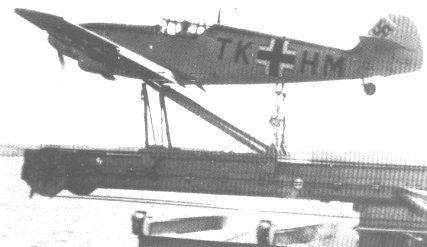Messerschmitt Me 109T

|
Hitler's ambitious Z-plan for the expansion of the Kriegsmarine
included the construction of four fleet carriers. These carriers, in
cooperation with battleships of the Bismarck or H class, would have
been able to challenge the overstretched Royal Navy's supremacy in the
North Atlantic sea routes. With the plans for the carriers arose the
need to design and build carrier-borne aircraft. The famous
Junkers Ju 87 had a naval cousin, the
Junkers Ju 87C, for divebombing. The Fieseler Fi 167 was built as
a torpedo-attack aircraft. Naturally there was also a need to develop a
carrier fighter for local air defense and escort purposes. The most
obvious method was to convert the existing, reliable
Messerschmitt Bf 109 for the new role. The converted carrier-borne fighter was designated the Me 109T (T for Träger, carrier). Basically it was an Me 109E-1 with minor conversions. A device was fitted onto the landing gear for launching by catapult, and an arresting hook was added to the fuselage. It was armed with an MG 17 firing through the engine hub and two MG 17s or 20mm MG FFs in the wings. The wingspan was increased by two feet for better lift during take-off and landing. The wings could also be folded for better storage in the confined space in a carrier. The Me 109T was powered by a Daimler Benz DB 601N engine and had a performance similar to that of the Me 109E4/N. A total of seventy Me 109Ts were built: 60 by Fieseler, 10 by Messerschmitt. Construction of Germany's first carrier, KMS Graf Zeppelin, however, was halted in 1940, when it was 80 per cent complete. Work resumed on a revised design in 1942 but was finally abandoned in 1943. The Me 109Ts were converted back to regular fighters and designated Me 109T-2s. The T-2 could carry four SC 50 bombs or one SC 250. Its range could be extended by carrying a 300-liter external fuel tank. All Me 109T-2s were lost by the end of 1944. |


